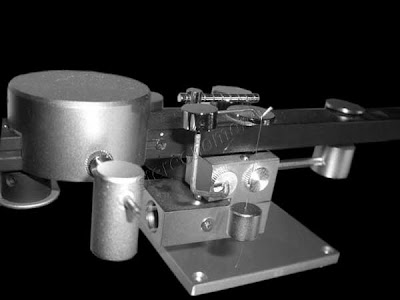
This unconventional tone arm is our answer to to-day's advanced record cutting technplogy. The DV/505 with its biaxial arm, dynamic and electro-magnetic damping systems and spring loaded tracking force, gives 100% cartridge performance. The DV/505 arm will extrat from the Dynavector cartridge the very maximum in quality and enable you to experience tremendous satisfaction from your records. The 1977 CES Design and Engineering Exibition selected and awarded the DV/505 tone arm. Why not treat yourself to this luxury - the experience will be well worth it.
In a radical departure from conventionally accepted ways of tone arm design, Onlife Research introduces its Dynavector DV-505 arm that looks and in many ways behaves like no other tone arm ever before. By its full technical designation it is called a "magnetically damped, inertia controlled, bi-axis massdivided, dual pivot, dynamically balanced tone arm," a lengthy description whose numerous unfamiliar terms already hint at the uniqueness of this innovative design. Details about features and functions are explained on the back page; the validity of the various design innovations will be demonstrated best, however, in a careful comparative listening test i n conjunction with a high fidelity reproduction system of the highest order of professional quality.

The Dynavector DV-505 Raises Tracing Fidelity to A New Level of Accuracy.
A tone arm has to support and guide the phono cartridge in its path along the record groove, permitting it to faithfully follow all groove excursions at a light tracking force, without however vibrating, resonating or in any other way moving itself. Contrary to conventional thinking, this "steadiness" in a tonearm is best achieved by giving the arm a relatively high mechanical mass. Records, however, being mass produced, almost invariably show some small degree of warp which forces the arm up and down when playing. A n arm of large mass would, because of its high inertia, cause rather violent changes in tracking force. Ideally a tone arm should fulfill two conflicting demands: large mass for steadiness in the horizontal plane, low mass for the vertical plane. A tone arm should actually be two tone arms. Impossible?
The Dual-Pivot Dynamic Balance Dynavector Arm.
The Dynavector DV-505 is two arms in one. Its main arm section of large mass, pivoted to move only in the horizontal plane, provides a superb degree of steadiness; its sub section, separately pivoted to move only vertically, is of low mass, and tracking force is applied by a precision calibrated spring mechanism. It thus provides perfect tracking of lateral a n d vertical groove modulations without being affected by record warp.

Dynamic Damping System. Eliminates Arm Resonance
Every tone arm, being a physical mass, tends to resonate at or around a certain frequency, and this arm resonance can seriously affect the cartridge's tracking fidelity — the sound becomes "muddied" and loses all transparency and clarity. Resonances in conventional tone arms have not really been eliminated but only moved down into the subsonic region at around 10 to 20 Hz where they show up as a strong peak — up to 10 dB — in the system frequency response curve.
To solve this problem in the Dynavector DV-505, a subsidiary vibrating mass consisting of a spring bob weight is provided inside the U-shaped main arm, with its mass calculated precisely in such a way that it will resonate at the same frequency — but in exactly opposite phase — as the arm itself. This opposite resonance has the effect of cancelling out any arm resonance.
Constant, Unvarying Tracking Force
Vertical tracking force is applied by a precision made spiral spring device. This "dynamic balance" system maintains unvarying tracking force regardless of record warp.
Tracking force adjustment is done by means of a dial mounted on the sub arm pivot.

Electro-Magnetic Damping System for Perfect Tracking.
An additional measure of damping is effected by the electromagnetic damping system. A curved rod attached to the rear of the arm is embedded in a magnetic field supplied by two permanent magnets. Any minute movement of the rod, due to an undamped arm resonance, causes an eddy current to be induced in the rod, which in turn interacts with the magnetic field to return the system to its rest state. As response graphs show, the arm thus becomes virtually free from any resonance phenomenon and permits perfect tracking of even subsonic frequencies. This highly effective damping also makes the arm impervious to acoustic feedback and vibrations transmitted through the floor and turntable cabinet, to guarantee utmost clarity of sound under all operating conditions.
Free-standing Type
Thanks to its heavy base, the Dynavector arm can be placed freely on any turntable without requiring screw mounting. (Mounting holes are, however, provided.) A template is supplied for correct overhang adjustment.

Overall lenght: 335 mm incl. head shell
Effective lenght: 241 mm
Offset angle: 21,5 degrees
Lateral tracking error: 0° at inner grooves, 2,2° at outer grooves
Overhang: 15 mm
Adjustable height range: 38 - 70 mm
Lateral and vertical sensitivity: less than 50 mg
Head shell connection: standard EIA type 4-pole connection

Nessun commento:
Posta un commento